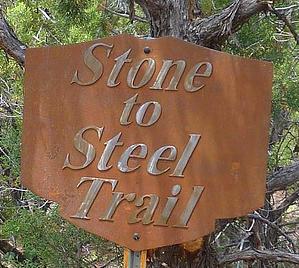| Guide | ♦ | 4 Triplogs | 0 Topics |
details | drive | no permit | forecast | route |
stats |
photos | triplogs | topics | location |
| 5 | 4 | 0 |
 History HistoryThe first large steel dam in the world was constructed in semi-remote Johnson Canyon, three miles east of Ashfork and fifteen miles west of Williams to supply water to the Atchison, Topeka, and Santa Fe Railroad over 100 years ago. Francis H. Bainbridge, a civil engineer working for the railroad, invented and patented the steel dam, which was fabricated by the Wisconsin Bridge and Iron Company and shipped to the site for erection. The development of this new water supply for the railroad was a key to opening the door to the arid west. The steel dam, built in 1898, was constructed with 24 curved plates sloped downstream giving this unique structure a scalloped appearance. The central steel section is 184 feet long, 46 feet high, and weighs an estimated 460,000 pounds.
Hike Either of these dams is a worthy hike destination, but there is now the capability of seeing them BOTH on one easy hike. The one-month-old (with some short sections remaining under construction) Stone to Steel Trail offers an easy, winding path downstream from the Stone Dam to the Steel Dam and back. Walk down and inspect the Stone Dam. On my visit, the water was about 8' below the dam brink and was somewhat murky. You will likely see birds of prey around the lake and as far as I can discern the lake is, or at one time was stocked with bass and other sport fish (as is the lake created by the Steel Dam). From the fisherman rubbish around the banks, I believe it is still stocked. (Why is it that the litterbugs always seem to drink Bud Light? -- I do not believe that I have EVER seen a craft beer bottle or can as litter.) Anyway... from the south side of the dam take the obvious, signed trail west as it meanders for about 3/4 mile to the Steel Dam. Explore the steel dam and if game head to the north side of the creek and check out Steel Crater. On the downstream side below the steel dam, you will find some small pools that are rife with bright green frogs, and in the girder structure behind the dam is some sort of large bird nest. (Maybe hawk or osprey?) Once finished in this area, head back the way you came. Since you are so close, I would recommend you venture over to the Johnson Railroad Tunnel before or after this hike. Note Once back on Old 66 we traveled west to see what there was to see, exploring the side dirt roads. We eventually ended at the western terminus of Old 66 at a locked gate ( see map ) which precludes making this into a loop affair. Gate Policy: If a gate is closed upon arrival, leave it closed after you go through. If it is open, leave it open. Leaving a closed gate open may put cattle in danger. Closing an open gate may cut them off from water. Please be respectful, leave gates as found. The exception is signage on the gate directing you otherwise. Kaibab FS Details The Stone and Steel Dams were built by the Atchison, Topeka and Santa Fe Railroad to store water for use for the railroad operations. The Stone Dam, also known as the Masonry Dam, was constructed in 1911, and is located on private land owned by John F. Long. The Ashfork Development Association, along with the Ashfork Museum and Information Center, help to manage the dam and reservoir which are open to the public for recreation and are accessible via a two track road located just north of Historic Route 66. The Steel Dam, also known as the Ash Fork-Bainbridge Steel Dam, was constructed in 1895 and is located about 0.5 miles down the drainage (to the west) of the Stone Dam on land managed by the Kaibab National Forest. The Steel Dam is open for public use, but the road to access it is not very well maintained along the north side of the dam. Check out the Official Route and Triplogs. Leave No Trace and +Add a Triplog after your hike to support this local community. | ||||||||||||||||||||||||||||||||||||||||||||||||||||||||||||||||||||||||||||||||||||||||||||||||
 Route Editor
Route Editor




